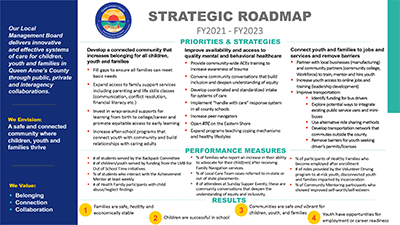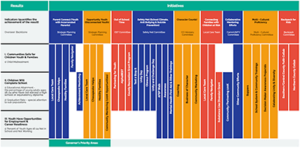What does the QAC LMB do?
What does the QAC LMB do?
As an LMB, the Partnership seeks to reform the system serving children and families. Specifically LMBs:
- Coordinate efforts of multiple agencies in the child serving system so they are not fragmented, duplicative or categorical;
- Shift the programmatic focus from reacting to problems to prevention and early intervention services;
- Strengthen the decision-making capacity at the local level through interagency collaboration; and
- Decrease out-of-home placement for the children and youth.
LMBs were established in Maryland when reformers recognized that despite the investment of significant public and private resources to support Maryland children and families, a large number of children at risk were not being served well by existing services. These services tended to be fragmented, inflexible and overly centralized.
Community Partnership's Key Principles
Since its designation as an LMB in 1997, Queen Anne’s Community Partnership has expanded its concept of its mission beyond this relatively small number of at risk families to include all children and families in the county. The Partnership’s approach is characterized by several key principles:
- Children and families with problems live in a community, and that their needs cannot be addressed without addressing the capacity of that community to support families and children.
- Funding service programs is not enough; funders must have a strategic vision of how they want to change systems so that these systems better support children and families.
- Resources must be shifted from a reactive approach to one of intervening early when a child or family is struggling.
- Coalitions and partnerships between public agencies, private providers, the faith community and advocates are critical. Participating organizations should include education, social services, health, and law enforcement agencies and service providers. Service approaches and programs are developed with the idea that they have multiple stakeholders, and enhance a coordinated system.
- Planning must be locally based, with the recognition that no one understands the strengths and weaknesses of their communities better than those who live and work in those communities.
- Planning must be data driven. The need for services is determined based on objective research. Program models are developed based on research based prototypes which have show evidence of success elsewhere. Evaluation criteria for success are based on what measurable outcomes a program can produce.
- Best practices should be promoted that are child centered, family focused and based on individual strengths and needs.
What functions does the Community Partnership perform?
The Partnership follows these principles as it seeks to create a stable and healthy environment in Queen Anne’s County for children and families. It carries out its mission through a comprehensive needs assessment and strategic planning process. Based on its plan, the Community Partnership performs several key functions:
- First it serves as a catalyst and enabler for the community to generate new resources. The Partnership may stimulate or encourage action by other agencies, support other partners through collaboration, or participate in a joint project. It focuses on building overall community capacity to bring change, rather than on which agency is providing which service, or which stakeholder can claim credit for progress on addressing a problem.
- Second, the Partnership uses its own funds as leverage to build a system of services and to fill in gaps in resources. Based on needs it has identified, it seeks funding from a variety of sources. Once funding is secured, the Partnership awards contracts to qualified service providers. It then monitors each contract, evaluates results and holds the vendor accountable for the provision of quality services.
What does the board and staff look like?
A board of directors, including a student, oversees the work of the Partnership. The Board is appointed by the County Commissioners. The Board includes the heads of the County Board of Education, Social Services, Health Department, Juvenile Services and Core Services Agency, who are appointed by virtue of their position. Additionally, the Board recruits members that represent all the facets of the community including parents, the nonprofit sector, faith communities, business, recreation and law enforcement. The Board meets nine times a year, and shapes all the Partnership’s planning and funding decisions.
The Partnership is a Department of Queen Anne’s County and has a staff of five County employees. The Partnership operates in accordance with all County laws and policies, including the County procurement law, budget requirements, and personnel law and procedures.


